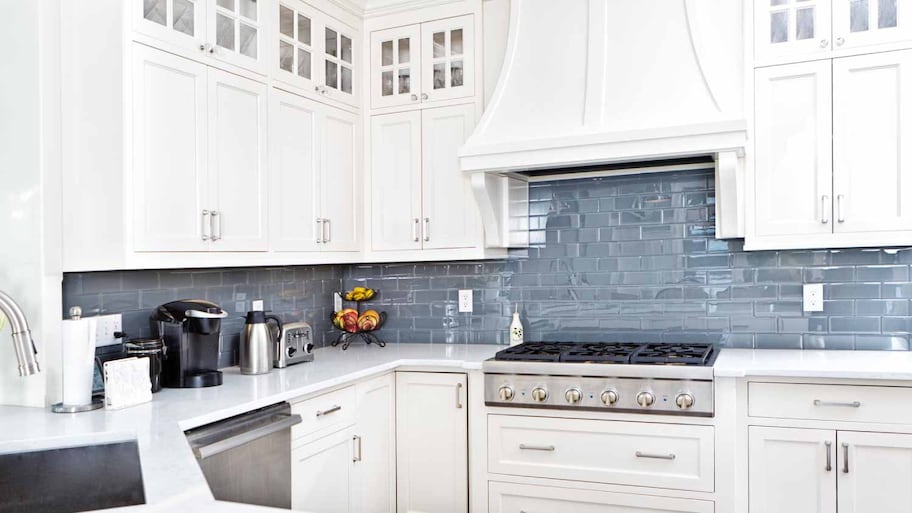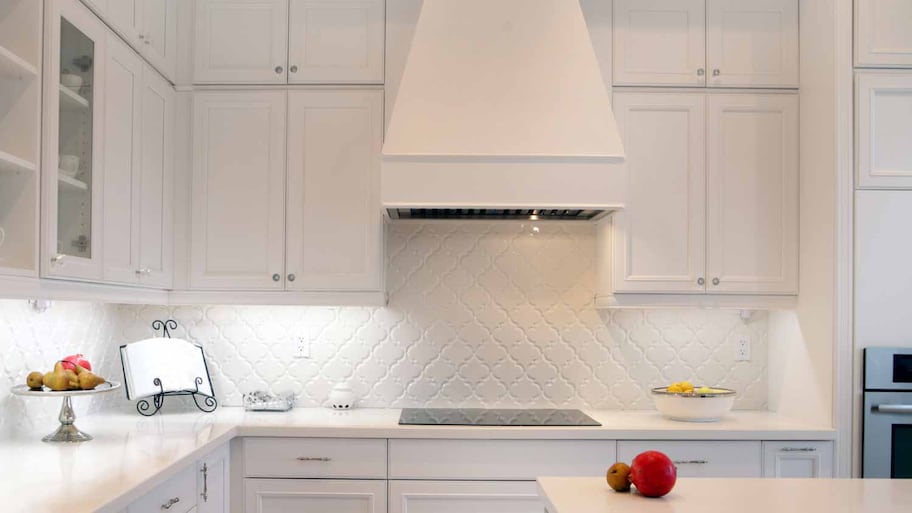Do You Need a Backsplash in Your Kitchen? Beautify and Protect Your Remodel
Add a splash of protection to your kitchen walls


Highlights
Most building codes don't require backsplashes.
The protective nature of backsplashes makes them a valuable kitchen component.
Backsplashes beautify the kitchen and protect the walls from costly damage.
A backsplash installation project costs $1,000 on average.
Kitchen backsplashes are more than just pretty feature, though their beauty certainly doesn’t hurt. Aside from being a potential focal point for the room, a backsplash provides a barrier between vulnerable drywall or plaster behind your kitchen countertops, protecting it from costly water damage and other hazards.
However, some homeowners like the backsplash look more than others, which raises the question: Do you need a backsplash in the kitchen? Technically, no. But there is a slew of reasons to consider one. Learn about the different backsplash options to protect and beautify your kitchen.
What Is a Backsplash?
The technical definition of a backsplash is anything installed at the rear of a countertop that keeps water, grease, and other damaging material from contacting the wall behind it. However, the materials and appearance of that installation have few rules other than that they protect the wall.
Many countertop manufacturers integrate backsplashes into their designs. This integration is common in laminate countertops, many of which come with a roughly 4-inch-high edge at the rear that serves as a backsplash. However, the integrated look isn't everybody's favorite, and countertops today come in a massive variety of materials, most of which don't have integrated backsplashes.
Modern backsplashes are often materials added to the wall at the back of countertops. The materials can be almost anything you can think of, provided they're more durable and protective than the bare wall they cover. A kitchen backsplash can be anywhere from a few inches tall to ceiling height.
Do You Need a Backsplash?
The International Building Code, or IBC, doesn't require the installation of a kitchen backsplash, so, no, your kitchen doesn't technically need one in most circumstances. However, local building codes can vary, so it doesn’t hurt to check with your municipality about all requirements when you do a home improvement project.
Building and remodeling inspectors will likely highly recommend, or even require, installing something to protect the wall if you choose not to install a traditional backsplash.
Benefits of Having a Kitchen Backsplash
Kitchen backsplashes can be far more than simple protective wall coverings. Modern and classic design materials can create just about any look you can imagine for your kitchen. In fact, installing a backsplash to both beautify and protect your kitchen remodel has never been easier.
A kitchen backsplash works by stopping spilled, splattered, or otherwise loose food and liquid materials from reaching the vulnerable wall material. Stopping the contact between the wall and the loose material keeps it from getting behind the countertop, where it can damage the wall.
Liquids that get behind the countertops will likely cause damage and can create rot and mold, which aren't just ugly but can also affect the home's air quality and be expensive to eradicate and repair.
Backsplash Types and Materials

Almost any protective building material can transform into a backsplash. Here are just a few examples.
Integrated
Many laminate countertop manufacturers integrate a low backsplash into their designs. Stone, composite, and other solid surface countertop makers may offer matching or contrasting backsplash pieces as an option. You can use integrated backsplashes alone or combine the look with taller backsplash materials above them.
Costs and installation requirements are minimal, as the cost is often part of the countertop price, and the pieces are designed to work with the counters.
Tile
The most common modern backsplash material is tile, and nearly any size and type is possible. Consider glass, ceramic, porcelain, or any other kind. Mixing and matching for contrast is a popular design choice, as are solid-color options for either a bold or subtle appearance. The price for tile backsplashes runs anywhere from around $1 to $25 per square foot.
Stone
Stone and engineered stove backsplashes are truly stand-out kitchen design elements. These materials are common for homeowners who want to show off their backsplashes as design focal points. Stone backsplashes often protect the wall behind a stove or sink as an accent piece to other backsplash materials. However, many homes feature more extensive stone backsplashes. Expect costs of between $5 and $45 per square foot, depending on type and quality.
Wood
While unprotected wood isn't considered a resilient material due to its vulnerability to water damage, protected wood can make for a beautiful backsplash. At a cost of between $2 and $30 per square foot, as long as the wood has a protective coating of paint, lacquer, polyurethane, or similar product, your imagination is the only design option limit.
Metal
Copper, stainless steel, tin, and others are among the various metals usable for backsplashes. Metal backsplashes are often used as accent pieces behind a stovetop, range hood, or sink area. The material costs between $10 and $65 per square foot, but the stunning results can be worth the steep price.
Faux Materials
To save a few dollars while appearing to have spent a fortune on your backsplash, consider faux materials such as stone or engineered stone facades or brick veneer tiles. Numerous types and styles are available at home centers and tile shops. A shopping trip or internet search will likely reveal many unique design ideas that cost as little as $3 per square foot.
Wallpaper
Wallpaper's popularity comes and goes as a wall-covering. However, wallpaper backsplashes are not only possible with modern materials but can be beautiful, too. Use water and stain-resistant wallpaper, but beyond that, choose any pattern and color you like to make a bold statement with your backsplash. While wallpaper installation costs are between $1 and $7 per square foot, expect to be nearer the high end of that scale for backsplashes due to the complexity of the work.
Peel-and-Stick Tiles
While not a new product, peel-and-stick tiles have come a long way from their starting point of being unreliable. Today's options are durable, protective, long-lasting and come in a wide range of styles, many of which are excellent for backsplashes to add a touch of kitchen beauty on a $1 to $10 per square foot budget.
Paint
Gloss, semi-gloss, satin, and equivalent paints can be excellent backsplash alternatives. Painting a kitchen, backsplash included, costs $2 to $6 per square foot. If you choose this option, remember to ensure the seal between the countertop and the wall is sealed with caulk sealant.
Backsplash Sizes
While a kitchen backsplash can consist of any number of material options, backsplash heights are also determined only by your design preference. Many homeowners prefer a subtle, few-inch-tall backsplash that offers just enough protection without having an overbearing design weight. Others like the look of backsplashes that span the gap between the countertop and the upper cabinets. While many opt to run their backsplashes all the way to the ceiling. Of course, you can always vary the heights in some areas to add to the design appeal.
Backsplash Installation Cost
To determine backsplash installation costs, homeowners, designers, or builders must measure for the backsplash carefully, especially when costly materials are involved. Pricing for professional installation averages $1,000, with a range of anywhere from $120 to do the job as a DIY project with inexpensive materials to $7,500 for a full-height, professionally installed marble or stone option.
DIY Backsplash Installation vs. Hiring a Pro
There are some factors to consider before deciding to install your own kitchen backsplash. Simply installing a backsplash in an existing kitchen isn't likely to require a permit in and of itself. On the other hand, if you're remodeling your kitchen and moving or replacing cabinets, electrical components, plumbing, or other vitals, your city inspections department will likely require a building permit.
Keep in mind that your kitchen likely has electrical circuits and outlets in the area where you're installing the backsplash. Understanding and having experience working with electricity in these areas is crucial to avoid severe injury or worse. Plumbing and other home system components may also exist behind the wall, which is something to remember if you plan to penetrate the surface for any reason, such as replacing damaged wall sections.
Finally, determine if your skillset is up to the task of installing the backsplash. Practicing on less visible portions may be wise before attempting the focal points.
To ensure a perfect installation and free up a weekend or two for other pursuits, consider hiring a local backsplash installer who can perform the job quickly and safely while making the most of your investment.
Frequently Asked Questions
In most cases, you can install a backsplash directly onto prepped drywall. However, as long as you're taking the time to install something that protects your walls from damage, removing existing drywall and installing water-resistant drywall, tile backer board, or cement board will add even more protection. Some municipalities may require using water-resistant materials in some kitchen areas but if not, properly installed drywall is strong enough to carry the load of backsplashes.
The value that installing a backsplash in a kitchen can have is challenging to measure in terms of monetary return on investment. The actual selling-value ROI is quite low. Meaning the home's selling price won't significantly increase because of a backsplash installation. However, having an attractive backsplash in a home you're selling can increase its purchasing appeal and let the buyer know that the wall behind the backsplash is protected.
